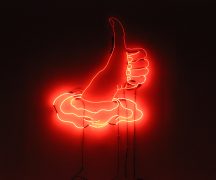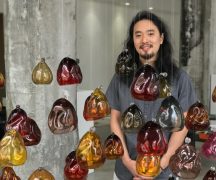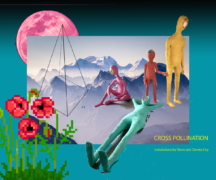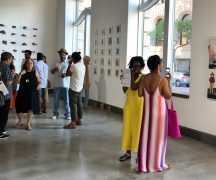By DAVID DUPONT
BG Independent News
Inside the River House Arts gallery in the Secor Building in downtown Toledo, art lovers can find respite from the dreariness of winter.
Projected on the wall is an image of glistening water with bubbles rising to the surface looking up through the surf at the Hawaiian sky. The water is reflected in the surfaces of the reflective concave domes spread across the gallery floor. The domes were salvaged from a failed solar panel plant. The projector is hidden beneath one of the domes.
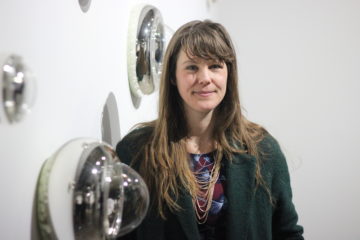
Alli Hoag
The work is part of “Alternative Beginnings,” a solo show of work by glass artist Alli Hoag. The exhibit continues in the gallery through Jan. 27. (For information on hours click.)
The art in the show plays on Hoag’s fascination with nature and how we perceive it.
In an age when so much is at a digital remove, Hoag wants to engage the viewer’s body in the act of understanding art. Most of the pieces use convex glass domes. Inside are cast glass images of moths, canaries, and hummingbirds.
“Using the distorted lens makes them (the viewers) evaluate what they’re seeing,” the artist said. It’s as if they are “seeing with a new set of eyes.”
“They have to be very present to understand the work, and the work changes as they move through the space.”
People will view the work from a different angle depending on their height, or where they are standing in the gallery. As they move, that view changes.
The glass domes at once magnify the image, and yet keep it at a distance.
Hoag aims to give the viewer both this physical experience and the psychological experience of “being immersed in your own thoughts, your daydreams, your internal dialogue.”
The creatures are set against mirrors. Sometimes the reflection completes the form. “It’s a really fun way to take these elements that I cast and make them a little more than themselves within this space,” she said.
A living hummingbird could never be caught this still. The frame of the work includes parts of an old map, so it provides the intimate look at the bird and a wider view of a larger world. Neither of these views are possible without the intercession of art.
A partial canary, set in industrial glass made by Pilkington, engages the idea of decay, and “the way we can resuscitate things we remember in daydreams, memories, and imagination,” Hoag said
Hoag’s fascination with nature is rooted in her childhood. Hoag, 36, grew up in Palm Beach, Florida. “The nature of Florida is pretty exotic and beautiful and really wild when you get away from the cities.”
Each summer, her family would travel between Florida and the Bahamas. “We would go fishing and diving and basically live off the ocean for a month every summer.”
She memorized the fish identification charts.
On land she attended Catholic school. “I love all sorts of myths and religions,” Hoag said. “Myth, technology, and science are all poking at this thing we’re trying to understand, the unknown. I pull from all the stories that these three areas talk about to get to that angle to overcome that distance … to find ways we can connect to the things outside of ourselves.”
When she went off to Tulane University for college, she majored in pre-med … for a while. In her first semester, she took a glass course.
Hoag said she’d always been interested in drawing and making things. Her uncle and granddaddy were engineers. “We had a make-it-yourself mentality.” Glass brought these elements together.
Hoag said she didn’t know anything about glass or how it was made. It was a “mysterious, other worldly product. It was like molten lava.” Making it was “totally scary and exciting and gave me confidence.”
“No one’s ever trusted me before with my safety before like that,” she said.
Hoag learned to cast glass and weld. At 18, “it was so difficult, so intriguing, and it still is. It takes all your concentration, all your focus.”
What results can always be improved. Even now as she looks at her work she sees things she wants to perfect in future work. “It really gives you the thrill of the chase.”
Having turned to fine art, Hoag realized, she’d best not be paying $30,000 a year in tuition. At this point, her father had been living in Hawaii. So she was able to get Hawaii resident status and attend the University of Hawaii where she studied glass with Rick Mills.
After graduating, Hoag returned to Florida where her mother and her husband ran a construction business in the state’s booming economy. Hoag worked for them doing estimates for jobs and being an assistant superintendent on job sites.
The pay allowed her to maintain a studio, but “my heart wasn’t in it.” Then in 2008 the economy crashed. The firm closed down, and she lost her job. Hoag waitressed and did office work. She lived in a home that was in the process of being foreclosed. But she said there were so many houses in foreclosure that as long as a tenant maintained the lawn and the house, the bank didn’t move in.
She built a kiln in the house and developed new work. She set her sights on graduate school in anywhere but Florida. Hoag ended up at Alfred University in New York’s Southern Tier.
There she started working with mirrors in the first stage of the work she’s now exhibiting. After graduating she taught at Alfred and then in Norway, before coming to Bowling Green State University on an interim appointment. She was hired into a tenure track position in 2016.
Now she’s putting the construction skills she’s acquired over the years into renovating her new home and studio in the Old West End. “Nowhere else in the world could I do that.”


